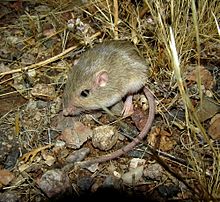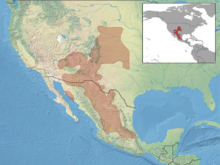Perognathus flavus
| Silky pocket mouse | |
|---|---|
 |
|
| Scientific classification | |
| Kingdom: | Animalia |
| Phylum: | Chordata |
| Class: | Mammalia |
| Order: | Rodentia |
| Family: | Heteromyidae |
| Genus: | Perognathus |
| Species: | P. flavus |
| Binomial name | |
|
Perognathus flavus Baird, 1855 |
|
 |
|
| Silky pocket mouse distribution in brown | |
The silky pocket mouse (Perognathus flavus) is a species of rodent in the family Heteromyidae. It is found in northern and central Mexico and the southwest region of the United States. It is a species of least concern, according to the IUCN, with no known major threats. The silky pocket mouse eats seeds, succulent parts of plants and nuts, and carries food in its cheek pouches. It lives in low valley bottoms with soft soils, among weeds and shrubs, where it burrows in the sand to bury seed caches. The species is more tolerant of harsh habitat conditions than other pocket mice.
The silky pocket mouse is the smallest pocket mouse in the family Heteromyidae, though otherwise is very similar in appearance to the other members of the genus Perognathus. Its relatively short tail, which is buff or dusky colored above and white below, does not have a tuft of hair at the tip and is always shorter than the combined length of the head and body, which average about 60 mm (2.4 in). The upper parts are ochre or yellowish-buff, with many black-tipped hairs. The underparts and the forelegs are white. Behind the ears there are clear buff patches without black-tipped hairs and there is a narrow strip of plain buff between the dorsal coloring and the underparts. The species exhibits little sexual dimorphism, but the male tends to have a slightly longer tail.
The silky pocket mouse is endemic to the southern United States and Mexico. It is present in the states of South Dakota, Nebraska, Utah, Colorado, Kansas, Arizona, New Mexico, Texas and Oklahoma and possibly Wyoming (where it may be extinct). In Mexico, it is present in most of the central plateau. The silky pocket mouse occurs in arid and semiarid grassland, sandy and rocky places, Pinus - Juniper areas, Artemisia flats, shrublands and areas with Yucca and cactus.
The silky pocket mouse is mainly nocturnal and lives in a burrow by day. In warmer weather it consumes cached food in the afternoon before emerging on the surface to forage in the evening. It mostly collects grass and weed seeds but also eats some green leafy material. It takes the husks off the seeds before storing them in its cheek pouches and carrying them back to its burrow where they are cached. A silky pocket mouse collects an average of .154 g (0.01 oz) of seed on each sortie. When a pile of 25 g (0.88 oz) was deposited near a burrow (sufficient for maintenance for up to 10 days), the pocket mouse collected and stored it all in one night, and still emerged to forage on succeeding nights. In cold weather it occasionally forages by day, and in really bad weather it may not come out of the burrow for several days.
...
Wikipedia

